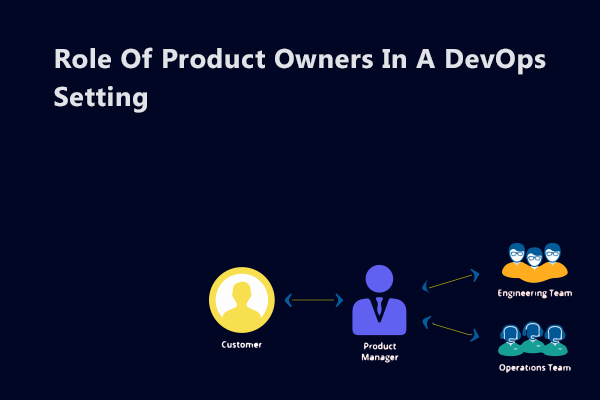
Role Of Product Owners In A DevOps Setting
In recent years, the DevOps method of combining the talents of developers with those of IT operations has proven to be the greatest change in software development. The teams can write, delegate, and maintain the system that evolves according to user needs and feedback.
DevOps encourages a workflow based on frequent integration and iteration—quick feedback to identify problems early. However, this approach can lead to trouble in environments like production, where significant changes or updates may be required.
The DevOps method, which was created to unite software development and operations, holds some challenges compared to the classic Scrum method in some areas, particularly with regard to the product owner's role.
In this article, we will see the challenges of the Product Owner (PO) and mitigate those while working in the DevOps setting.
Product Owners In Pre-DevOps Era
Product owners have traditionally been responsible for managing backlogs and prioritizing work, ensuring that the most valuable work comes first (in the form of stories) in the development environment. Communication with business analysts, shareholders, architects, and others who contribute to what requires to be created ensures that the backlog is maintained. Typically, the product owner tries to provide enough work in the backlog to keep the team busy for several iterations.
The Product Owner is usually the person responsible for making sure that the overall vision for the product is followed, and that the product does not stray too far from it. One way to do this is by creating iteration targets to figure out what needs to be done in an iteration, as opposed to what has to be done.
In a traditional environment, the product owner usually interacts with the development team during a Scrum ceremony or when team members need help. The POs typically spend a lot of time in the future, dealing with upcoming requirements and ensuring that they are broken down into manageable tasks.
Challenges Of Product Owners
Working in a DevOps approach product owners’ traditional behaviour faces some new challenges. The traditional method of using backlog as a buffer, accumulating it for the next few iterations, and keeping it behind, makes little sense in the world of fast-action environments where feedback is quick. Alternatively, it stays relevant to all items where nothing is there to prioritize.
For the most part, system development work does not continue once a system is in production because it takes a long time to get them up and running or because they are maintained by the operations or any maintenance team. In DevOps, the development team that builds the system also maintains it in production. This allows them to turn around bugs and other problems quickly.
Multiple tools are required to perform Continuous Integration/Continuous Deployment (CI/CD) and other key DevOps practices. There are a number of tools, depending on the configuration, which each team uses and supports. The main team uses them or installs them when needed. In any case, this results in technical tasks for developers with which the PO must inevitably be added in backlogs.
Due to the fast-paced nature, when the product is being developed and implemented rapidly, it may be hard for the product owner to keep the product vision in mind. It also may be hard for the product owner to make sure that people are working on important tasks that are not yet scripted.
Tips For DevOps Product Owner
Though the Product Owners face more challenges, there are also ways available to mitigate those issues. Here are some tips for Product owners when working in the DevOps environment.
1. Find Absolute Minimum To Go For Production
First, try to make sure knowing the minimum to produce with. This is sometimes referred to as the Minimum Profitable Product (MVP). Second, understand how the system works. This is the direction to be followed when deciding which parts to build and in what order.
2. Reduce Task Size
To practice frequent deployment of production, it is necessary that the tasks are of the right size. They should also be defined so that they can be easily used.
If large tasks are difficult to complete, consider breaking them down into smaller tasks using feature flags to make sure the end-user doesn't see them until all required work is done. This allows you to start developing the production code and find hidden side effects without exposing the end-user to partially completed functionality.
3. Prioritization
DevOps’ key principle is quick feedback. To benefit from this, the product owner must constantly monitor the reviews and continually prioritize based on the feedback. All minor production errors are generally unacceptable and should be given priority, but any comments from users should be dealt with immediately thereafter.
Deployments in the DevOps environment occur at least once a week, product owners should prioritize backlog as often as there are installs and never let developers start with what is not a priority. The product owner must keep the product vision in mind when setting priorities.
4. Reduce Iteration Backlog
If the length of the iteration is not the same as your deployment cycle, consider how much you should put in the iteration at the beginning when it starts. Priorities often change based on the feedback we get when we start production, which means it is difficult to plan the entire iteration in advance. On the other hand, there is also a need to make sure that key features and valuable extras are in place, so some planning is necessary.
The solution is simply to limit the work that the team does at the beginning of the iteration and leave room for errors and feedback work.
One way to do this is to find the most valuable set of features that can be created at any given time and create an iteration goal to implement that feature. So, the team is committed to doing the work required for this particular position, but nothing else, so a new assignment can be included in the iteration if needed.
For this to work, latency priorities must constantly re-prioritize, and the team and product owner must have a constant dialogue about what other work needs to be done during the iterative backlog.
5. Make Sure Feedback Loop Between PO & Team
Since the development team oversees the system by monitoring user behaviour, they can understand what works and what doesn't. For the product owner and stakeholders to benefit from this input, it is important to create a feedback loop from the team to PO. This can be done by means of a formalized process or through informal channels.
Conclusion
While DevOps may impact the traditional responsibilities of a product owner, their behaviour can be modified in order to accommodate these changes thereby project can benefit from DevOps practice. Product Owners need to be involved in the product-backlog grooming process because it requires additional work from them; in contrast, it is easier for product owners to understand their end-users and consider their behaviour when implementing the product vision if they are involved.
LearnNow, an online elearning platform for entrepreneurs and aspiring professionals, offers a certification program specifically tailored to help you make the shift from being a learner to becoming an expert in your team/company. Know more, visit us at www.learnow.live or call us directly at +91 8951143636. Enroll in our corporate training program to differentiate yourself from others.
